Now that I’m back to visiting the bajo Flores Koreatown (sometimes it just takes facing your anxieties, and it helps to have friends willing to assist), there are all sorts of ingredients to look at. I thought I’d look at a trio of melons, or cucumbers (same family), that are in season right now. Two of these I’ve looked at briefly before, but I didn’t really do any research on them and didn’t do anything traditional with them, so I’m just going to pretend those posts don’t even exist.
From top to bottom – a chamoe, or Korean melon; a lao huang gua, which literally means old yellow melon, the huang gua is what a cucumber is called, and, it turns out, is exactly what it is – I always thought it was a specific variety of cucumber, but it’s actually a straightforward common cuke that’s left on the vine to mature until the skin gets brown and leather and the insides become, interestingly, less sweet and more starchy (who knew?); bitter melon, which goes by a wide variety of names depending on where it’s from (and which I’ll get to in the second post, since this will get too long otherwise).
As best I can tell, at least traditionally, and I asked around in Koreatown, Chamoe are simply eaten as a fruit. The general response was “just eat it”. Or put it in a fruit salad, or something of that sort. It’s less sweet than something like a honeydew or cantaloupe, but has a similar flavor, maybe crossed with a crisp cucumber. A pinch of salt and I was happy. I did find some non-traditional uses, like making it into jam and then using it to make danish pastries, but I couldn’t find any non “just eat it” sort of recipes traditional Korean cooking. I considered doing something creative and modern, but my whole intent with this post is to look at traditional uses. After the fact, by the way, I realized in reading several sites that talked about it, they really meant “just eat it” – rind, flesh, and seeds – which I hadn’t done, I’d scooped the seeds out and just eaten the flesh down to the thin rind.
And hey, if I have any Korean readers, or readers who really know Korean cuisine, with suggestions for something more interesting to do with this melon, please let me know!
So let’s move on to the Old Cucumber, or Old Yellow Melon, or any of several other names. (There is a Korean name for it too, olae doen oi, but interestingly in Barrio Correa anyway, they seem to use either the Chinese name lao huang gua or Spanish – pepino viejo.) It really does look just like a cucumber, only yellow-brown and leathery on the outside and the inside has gone from greenish-white to almost pure white. The general consensus was to peel it, and leave the seeds in unless they looked dried out, or, you just don’t want them. This recipe was recited to me by the woman who sold it to me, along with details for how to vary it up – but a family favorite. And, the basic recipe seems to jive with similar dishes out there.
So, the old cucumber, some pork (preferably belly or rib meat with some fat to it) – and here’s where the biggest variation came – she offered that it could be made with beef, chicken, shrimp, or tofu, or even with no protein added (though in that version she prefers to make it as a cold salad). Sesame oil, hondashi, which is basically just powdered dashi soup mix – or seaweed, bonito flakes, and msg (if you’re making this vegetarian, she said just to use msg by itself), garlic, salt, white pepper, black sesame seeds, and gochujang, or Korean chili paste (a mix of chili powder, barley or glutinous rice syrup, fermented soybeans, and salt). We had quite the chat!
While you’re cooking up some plain white rice, peel and dice the cucumber, coat it with the salt, let it sit for 15 minutes to drain the bitterness and extra liquid out of it, and then rinse it.
Chop or grind the pork (or other protein) and brown it in sesame oil – no seasoning at this point.
Add the drained cucumber, the chopped garlic, the hondashi (I only used about half the packet as I was making a small batch just for myself), and the pepper. Cook for about 4-5 minutes, stirring regularly.
Add the gochujang and some water, just enough to create a sauce, and the black sesame seeds. Cook for about another 4-5 minutes.
Serve over white rice. This is really, really delicious and I’m going to pop in and let her know that on my next trip back there. I’d make this again. I imagine, if you don’t have old cucumbers, you could even make this with fresh green cucumbers – it’ll change the flavor slightly, but I don’t think it would be that significant.
Flipping to Chinese cuisine, the most popular use of the lao huang gua, at least based on Google results, is Old Cucumber Soup. The various recipes out there don’t vary widely. They pretty much use a core of ingredients – the old cucumber, meat on the bone (beef, pork, chicken are the most common), dried squid or cuttlefish, dried scallops, Chinese red dates (another ingredient to come back to at some point), and salt. Garlic is pretty evenly split between those who use it and those who don’t. Other options based on recipes found – regular dates (instead of or in addition to the red ones, though I’m betting that’s not traditional); goji berries; a dollop of honey; corn (also probably not traditional); carrots (not sure, could be, probably not).
On my end, first off, no dried scallops. I found one place in Barrio Chino that sells them, at 1900 pesos/kilo (roughly $56/lb) and the smallest package they had was a half kilo – I wasn’t spending over a thousand pesos just to make soup for lunch for one person, even if it’s me, and especially only needing about 1/20th of the package. The primary reason for them is imparting more flavor, so instead, since I did have dried squid available (I only used about a third of that whole one there), I decided to ramp it up on the meats – beef and pork ribs, and while I didn’t have any chicken in the fridge or freezer, I did have a couple of frozen quail, so decided to throw one into the mix.
Pit the red dates, slice the garlic, cut the meats into smaller pieces, add salt and water and simmer away for 45-60 minutes. Then I fished the meats out, let them cool slightly, and shredded the meat off the bone and back into the pot. Added the peeled and diced old cuke (all the recipes made it clear that the seeds have to be removed for this dish), and simmered about another 15-20 minutes to cook it through and meld the flavors. Adjusted the salt.
And, lunch! Two bowls of this and I was supremely happy. Surprisingly, given that there’s no real seasoning or aromatics in this but one clove of garlic and a bit of salt, this is an extremely flavorful soup. I guess in a sense it’s kind of like the “bone broth” that’s become the hot thing (or is that over already?) – it’s nearly pure meat and bone extract flavors.
I’d happily make and serve either of these dishes again!
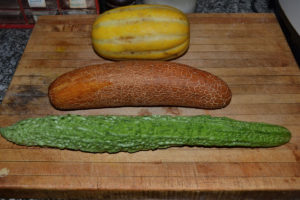
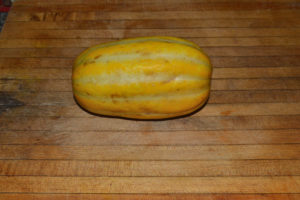
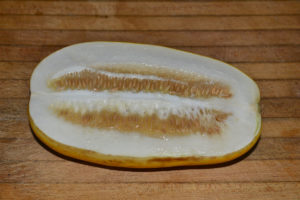
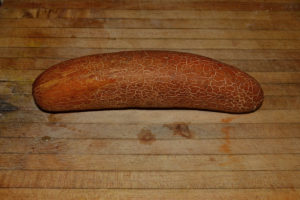
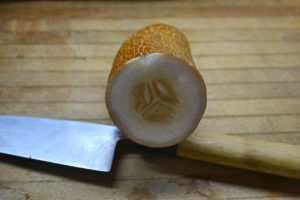
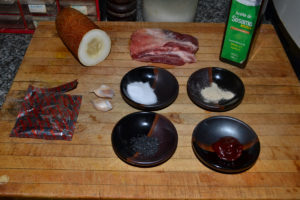
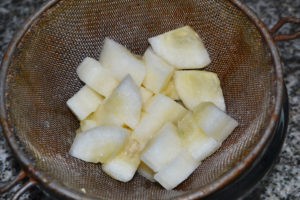
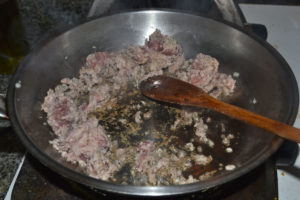
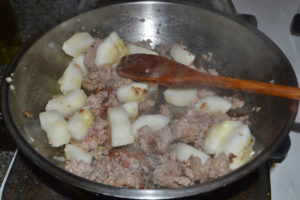
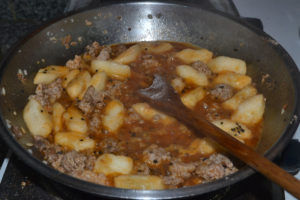
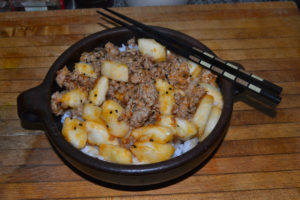
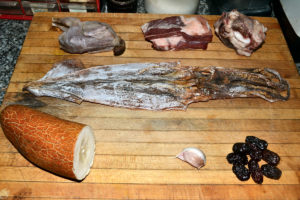
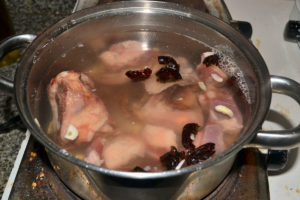
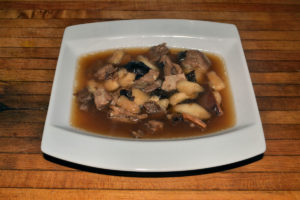
[…] & Chamoe Sorbet, Blueberries in Pineral – puree of chamoes, coconut milk, lime juice, peppermint, stevia, xanthan gum; chilled and churned into a sorbet; […]
[…] to round two of our Asian melons, and this time, the last of the three, Bitter Melon. Now, upfront, this is not one of my favorite […]
Usually in Korea they peel, de-seed and slice to eat. Sometimes decorative shapes are made to garnish desserts. It is also made into non spicy kimchi, drinks, and spicy salad.
The old cucumber in Korea is usually mixed with spicy seasoning and eaten, soups, stir fries.
In Germany I think they make it into pickles, Senf Gurken (mustard pickles), the skins are usually peeled.
Kind of what we ended up doing with them!
So sorry this took a year for me to reply. How did the pickles come out? I was thinking if I had some of the nogak I would make some Senf Gurken. Unfortunately this year all the cucumber plants went into the bellies of deer.
Oh, we didn’t make the pickles, we made them into a soup, as you also suggested. If you end up making the pickles, would love to hear about it and get a recipe!
In Korea, old cucumber is called “nogak” whereas “olae doen oi” literally just translates to “old cucumber”,
Cool, thanks!
I was basing the name “lao huang gua” on what they had it labeled as, and the “olae doen oi” was what I found it labeled as on the ‘net – I didn’t just make it up myself! But good to know how it should be called.